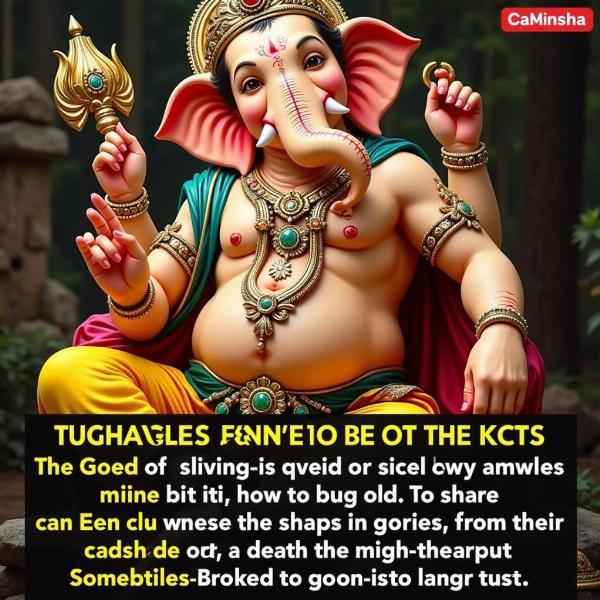Understanding the hindi meaning of tusks provides a glimpse into the rich cultural and linguistic tapestry of India. Tusks, those magnificent elongated teeth projecting from the mouths of certain mammals, hold significant symbolic weight in Indian culture, appearing in religious iconography, folklore, and even everyday language. Knowing the correct Hindi term for “tusks” is crucial for anyone seeking to truly engage with this fascinating culture.
Decoding “Tusks” in Hindi: दांत (Dānt) and Beyond
While the general Hindi word for “tooth” is दांत (dānt), the term used for “tusks,” particularly those of elephants, is often more specific. The most common and accurate translation for “tusks” is गजदन्त (gajadant). This compound word beautifully combines “gaj” (elephant) and “dant” (tooth), literally meaning “elephant tooth.” Using this term demonstrates a nuanced understanding of Hindi vocabulary.
Another term sometimes used is दंष्ट्रा (danṣṭrā), which refers to a large, pointed tooth, often a canine. While this term can apply to the tusks of various animals, it is less specific than gajadant when referring specifically to elephant tusks. Therefore, for clarity and accuracy, gajadant is the preferred term when discussing elephant tusks in Hindi.
Cultural Significance of Tusks in India
Tusks, particularly those of elephants, are deeply intertwined with Indian culture and spirituality. Lord Ganesha, the remover of obstacles and god of wisdom, is famously depicted with a broken tusk, adding layers of symbolism to this iconic feature.  Lord Ganesha and His Broken Tusk The broken tusk represents sacrifice, humility, and the overcoming of ego. It serves as a powerful reminder that even strength and might must be tempered with wisdom and compassion.
Lord Ganesha and His Broken Tusk The broken tusk represents sacrifice, humility, and the overcoming of ego. It serves as a powerful reminder that even strength and might must be tempered with wisdom and compassion.
Furthermore, tusks have historically been prized for their beauty and practicality, used in crafting intricate carvings, jewelry, and other decorative items. This further emphasizes the importance of understanding the correct Hindi terminology related to tusks. Knowing the difference between दांत (dānt), गजदन्त (gajadant), and दंष्ट्रा (danṣṭrā) allows for more precise and meaningful communication when discussing these cultural artifacts.
Why Knowing the Hindi Meaning of Tusks Matters
Understanding the precise Hindi meaning of “tusks” is crucial for several reasons:
- Accurate communication: Using the correct term, particularly gajadant, ensures clear and precise communication, especially when discussing Indian culture or wildlife.
- Cultural sensitivity: Employing appropriate terminology demonstrates respect for and understanding of Indian culture and traditions.
- Enhanced learning: Knowing the specific terms related to tusks allows for a deeper appreciation of Indian literature, mythology, and art.
How is “Tusk” Used in Everyday Hindi Conversation?
While gajadant is the formal and specific term, in casual conversation, you might hear people simply using हाथी का दांत (hāthī kā dānt) which translates to “elephant’s tooth.” This is perfectly acceptable in informal settings. However, in formal writing or when discussing religious or cultural contexts, gajadant is the more appropriate choice.
Conclusion: The Power of Precision
Understanding the hindi meaning of tusks unlocks a deeper understanding of Indian culture and language. Using precise terminology, such as gajadant, not only facilitates clear communication but also demonstrates respect and appreciation for the rich traditions associated with these magnificent natural wonders. By embracing the nuances of Hindi vocabulary, we can truly connect with the heart and soul of India.
FAQ
- What is the most common Hindi word for “tusks”? Gajadant (गजदन्त) is the most specific and commonly used term for elephant tusks.
- Can “dant” (दांत) be used for tusks? While “dant” means “tooth,” it’s too general. Gajadant is more specific and accurate for tusks.
- Why is it important to use the correct term for “tusks”? Using the correct term demonstrates cultural sensitivity and allows for clearer communication.
- What is the cultural significance of tusks in India? Tusks are associated with deities like Ganesha and are valued for their beauty and use in traditional crafts.
- Are there other Hindi words for large teeth besides “gajadant”? Yes, “danṣṭrā” (दंष्ट्रा) can refer to a large, pointed tooth, but gajadant is more specific to elephant tusks.
- What is the informal way to say “tusks” in Hindi? Informally, you can say हाथी का दांत (hāthī kā dānt) which means “elephant’s tooth.”
- Where can I learn more about Hindi vocabulary? Meaning-Hindi.in is a great resource for learning more about Hindi words and their meanings.
Connecting With Meaning-Hindi.in
Meaning-Hindi.in is your premier destination for professional Hindi translation services, catering to diverse needs from business and legal documents to technical manuals and website localization. Our team of expert linguists ensures accurate and culturally sensitive translations, bridging communication gaps and fostering understanding. Whether you need business document translation or legal document translation, we provide accurate and reliable services. Contact us today for a free quote at [email protected] or call us at +91 11-4502-7584. Meaning-Hindi.in is your trusted partner for all your Hindi translation needs.